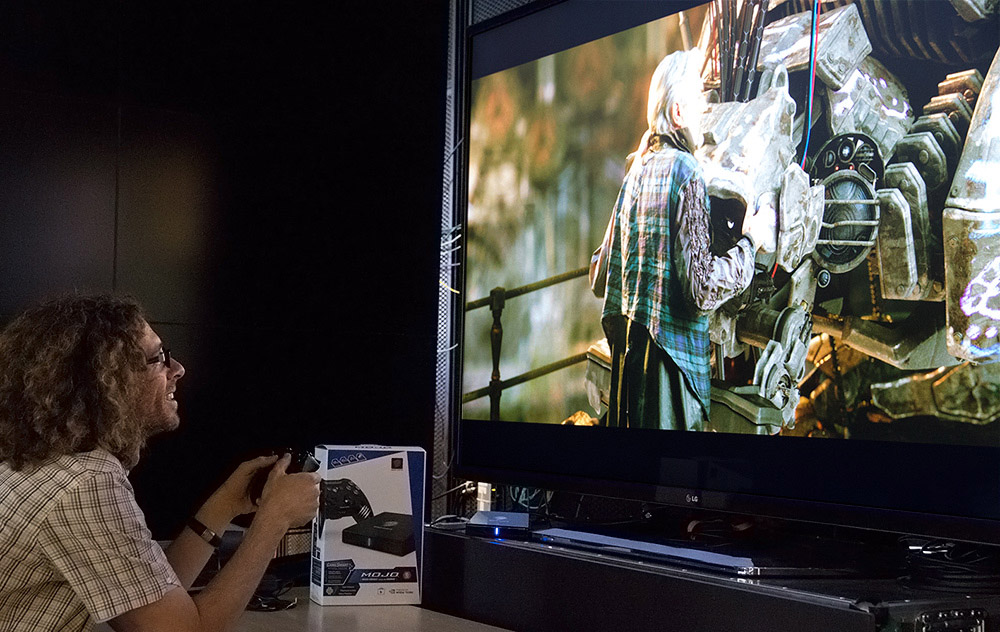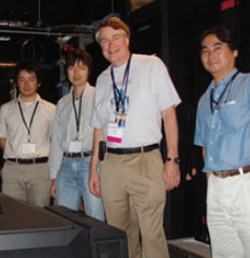Qualcomm Institute Researcher Tests World’s First 4K Android Game Console
Published Date
By:
- Doug Ramsey
Share This:
Article Content

UC San Diego project scientist Todd Margolis tests the M.O.J.O. micro-console for Android on LG 82" 4K UHD TV.
The 4K video format for digital cinema is now making its way into videogames and other digital media as consumers chase after as many pixels in their homes as possible. But 4K is a new-enough format that, when a maker of game consoles wanted to test its first device to handle 4K content, the company enlisted the help of Qualcomm Institute project scientist Todd Margolis at the University of California, San Diego.

In late 2005 Calit2 director Larry Smarr demonstrated the Sony 4K projector (foreground) shortly after it was installed in the institute's auditorium -- the first such ultra-high-definition system at a U.S. educational institution (and still in routine use).
The 4K format is officially 4,096 by 2,160 pixels – yielding a resolution that is approximately four times that of high-definition (HD) TV. The format is also called Ultra-HD, or UHD, and the Qualcomm Institute was the first educational institution in the U.S. to deploy a 4K projector, way back in 2005. Since then, the 4K-savvy institute has used the projector almost daily, including for the annual CineGrid conference hosted by the institute, which attracts movie studios, university researchers and distributors of digital media.
Fast forward to 2014 and the company Mad Catz, which recently introduced M.O.J.O., a micro-console for Android that the company claims is “the most powerful gaming and media box.” At the June 10-12 E3 Expo in Los Angeles, the premier event of the game industry, Mad Catz mounted a major push for the “ best-in-class solution” for gamers: instead of just handling HD, M.O.J.O. allows consumers to connect to a 4K UHD TV to play Android games, surf the Web, stream media, and so on. To do so, M.O.J.O. relies on a 1.8 GHz NVIDIA Tegra 4 processor with 16GB of onboard memory and 2GB of RAM – plus a graphics processing unit with “72 custom cores for the ultimate graphics performance.”
When Mad Catz wanted to test how well the console would work with different technologies and media, art director Sarah Attwood enlisted the help of the Qualcomm Institute’s Margolis.
“As a founding member of the CineGrid community and early proponent of next-generation digital cinema technologies, I agreed to help,” said Margolis. “We connected the M.O.J.O. to both an LG 84" 4K display and a 39" Seiki 4K display. The console recognized both displays with 4K UHD resolution perfectly, and their home screen scaled its app grid nicely to fill the large screen, so then we began stress testing it with 4K videos and games.”
Content could be played from M.O.J.O.’s internal memory or via a microSD card, or USB 3.0 external drive.
“We were pleased to find that the majority of applications scaled very nicely and performed extremely well on this first Android game console to support 4K,” said Margolis. “All the applications that used vector graphics looked fantastic in 4K and even most of the games using a lot of bitmaps still looked quite nice, except for some noticeable compression artifacts in some of the imagery. Also, applications that took advantage of anti-aliasing – especially on text – looked very good.”
Margolis also tested 4K videos played back from external USB 3.0 drives and locally, which worked “pretty well,” but some of the videos created at high bit rates – e.g., greater than 75 Megabits per second – experienced significant jitter during playback of certain parts.
The console is not yet 100% 4K ready, so Mad Catz is careful to call it “4K UHD capable.” For now, the console can play some 4K content, and upscale games and apps on a growing number of 4K TVs and displays. Some Android games upscale well to 4K, but few games yet are designed specifically for 4K. But that will change.
“As game designers begin to take into account the new affordances possible with 4K, I anticipate more exciting content to proliferate in the consumer gaming market,” concluded Margolis. “This is a big step toward bringing high-quality cinematic content into the home.”
The M.O.J.O. was featured on a syndicated broadcast segment on June 10 about the future of gaming and “new ways to game in 2014.” An estimated 900,000 people saw the video report.
As consumers purchase more 4K displays, experts recommend that they focus on systems that use the H.265/HEVC codec for streaming content, or VP9 (the Google open-source codec for 4K), so that today’s 4K displays are future-proofed against the day when older codecs such as H.264 will no longer be good enough for full 4K on the home screen. Meanwhile, consumers are increasingly creating 4K content of their own, because it’s featured on some advanced smartphones and cameras such as the GoPro Hero 3+. Those videos can also be streamed via YouTube or Vimeo, so there is ample evidence that the 4K revolution is finally happening – nearly a decade after the Qualcomm Institute first began showcasing 4K.
Share This:
You May Also Like
Stay in the Know
Keep up with all the latest from UC San Diego. Subscribe to the newsletter today.



